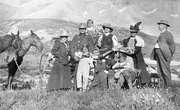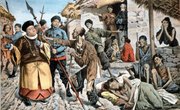Urban areas of the country are sometimes known as a paved paradise, but development can also take a toll on community development. The urban development processes relate to both negative and positive occurrences in the cities across the United States. People migrating to the urban areas can take advantage of the well-established infrastructure and available social benefits. The process of building a "community" within the urbanized areas misses the mark on meeting the needs of specific populations, specifically related to social class.
Infrastructure
People who migrate to urban areas mainly benefit from a well-established infrastructure in the cities. For example, they have access to transportation, airports, rail and bus stations. They also enjoy easy access to public facilities such as hospitals, libraries and schools. In the next 30 years, urban centers will house two-thirds of all people, worldwide. The safety net provided by the urban infrastructure of resources and public facilities will spark continued interest in living and working in large cities.
Public Advantages
The process of urban development has been favorable for the establishment of public services within the urban areas. Individuals living in the larger cities enjoy, for example, adequate policing and health services, counseling services and the opportunity to become civically engaged. Cities attract large companies and as a result, new jobs are created, enhancing public revenue. When Amazon chose a city for a second headquarter location, 50,000 new jobs were added to the urban coffers. New earners means additional additional tax benefits for the city. This increase in revenue can be reinvested into public works and resources for all citizens.
Building a "Community"
Despite the benefits of urban development, problems with inequality among the social groups continue to exist. Often referred to as a process of building a "community," the merging of different social classes is rare to observe. For example, in mixed-income neighborhoods, the distinction among people of different incomes is obvious. This creates a basis for discrimination based on the social status of those living in particular neighborhoods.
Response to Needs
Ongoing urban development attracts an increasing number of migrants. Migrant people come to urban centers in search of employment and resource assistant. A rise in the migrant population has narrowed job opportunities and made it more difficult for them to realize their economic dreams. The city of Chicago became a destination for migrant people in the 1990s. The number of newcomers to the city exceeded the employment opportunities available in various areas. As a result, many migrants remained unemployed and in poverty.
Related Articles
References
Writer Bio
Nikolay Danev began writing professionally in 2009. He has published articles on the United Kingdom, the European Union, political and legal issues, science, sociology, economics and other topics on various websites. Danev is currently a law student at Brunel University in West London.











